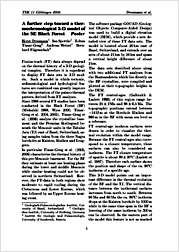A further step toward a thermochronological 3-D model of the SE Black Forest
Dresmann, Horst
Spottke, Ina
Timar-Geng, Zoltan
Wetzel, Andreas
Fügenschuh, Bernhard
Universitätsverlag Göttingen
Sammelband- / Konferenzbeitrag
Verlagsversion
Deutsch
Dresmann, Horst; Spottke, Ina; Timar-Geng, Zoltan; Wetzel, Andreas; Fügenschuh, Bernhard, 2006: A further step toward a thermochronological 3-D model of the SE Black Forest. In: Philipp, S., Leiss, B, Vollbrecht, A., Tanner, D. & Gudmundsson, A. (eds.): 11. Symposium "Tektonik, Struktur- und Kristallingeologie" , Univ.-Verl. Göttingen, 2006, S. 42 - 44., , DOI: 10.23689/fidgeo-1881.
 |
Dokument öffnen: |
Fission-track (FT) data always depend
on the thermal history of a 3-D geological
complex. Therefore it is expedient
to display FT data sets in 3-D models.
Such a model in which tectonic,
sedimentological and hydrological features
are combined can greatly improve the interpretation of the palaeo-thermal
pattern derived from FT analyses.
Since 1988 several FT studies have been
conducted in the Black Forest (BF)
(Michalski 1988, Wyss 2000, Timar-
Geng et al. 2004, 2005). Timar-Geng et
al. (2006) analyse the crystalline basement
and the Permian Rotliegend beneath
the Mesozoic units in the Tabular
Jura (TJ) east of Basel, Switzerland, using
samples taken from the three Nagra
boreholes at Kaisten, Riniken and Leuggern.
In particular Timar-Geng et al. (2005,
2006) characterise the thermal history of
this pre-Mesozoic basement. For the BF
they estimate at least one heating phase
during the lower and middle Mesozoic
while similar heating could not be observed
in northern Switzerland. However,
the FT-data in both regions show
moderate to rapid cooling during the
Cretaceous and Lower Eocene, which
was followed by an Upper Eocene heating
event.
The software package GOCAD (Geological
Objects Computer-Aided Design)
was used to build a digital elevation
model (DEM), which provide a new detailed
view of these FT data sets. The
model is located about 20 km east of
Basel, Switzerland, and extends over an
area of about 21km by 24 km and spans
a vertical height difference of about
2 km.
The data sets described above along
with two additional FT analyses from
the Buntsandstein which lies directly on
the BF crystalline, were compiled and
plotted at their topographic heights in
the DEM.
The FT central-ages (Galbraith &
Laslett 1993) of this region range between
25 ± 2Ma and 98 ± 6.5 Ma. The
topographic positions extend between
−1412m at the Borehole Riniken and
960m in the BF with mean sea level as
a reference.
FT central-age isochron surfaces were
drawn in order to visualize the thermal
evolution within the model range.
Because the FT central-ages also correspond
to a closure temperature, these
surfaces can also be considered an
isotherm. The FT closure temperature
of apatite is about 90±30°C (Laslett et
al. 1987). Therefore each surface shows
the position and shape of the ca. 90°C
isotherm of a specific age.
This 3-D model points out an important
difference in the thermal evolution
of the BF und the TJ. The vertical distance
between the isothermal surfaces
increases from north to south. Between
90Ma and 60Ma the ca. 90°C isotherm
drops at the Kaisten borehole by 1000m
while in the same time span in the BF a
lowering of the same isotherm by 300m
can be observed. In the eastern part of
the model this feature is not as marked
as in the west but nevertheless it is observable.
To explain this entirely different thermal
evolution it is necessary to turn to
the tectonic and other geological features
of the region. South of the exposed
BF crystalline and beneath the
TJ there lies an old Variscan structure:
the Permo-Carboniferous trough
(PCT). This trough strikes in WSWENE
direction and extends from Lake
Constance to the Bresse Graben and
contains up to 6000m of Palaeozoic sediments.
Additionally, some Variscan
fault structures strike in WNW–ESE direction
and cut both the BF an the
PCT, for example the Eggberg Fault
and the Vorwald Fault. Beside the tectonic
structures the hydrological characteristics
played an important role during the palaeo-thermal evolution. Circulating
hot fluids controlled the thermal
pattern. Variscan faults were often reactivated
during the Mesozoic (e.g. Wetzel
et al. 2003) and also during the
formation of the Upper Rhine Graben.
(e.g. Illies 1967) These faults are the
major water-conducting features in the
crystalline basement of the BF, joints
and fracture networks are tributaries.
Below the aquifers within the Mesozoic
of the TJ, the PCT trough sediments
predominantly act as an aquitard. Only
the border faults of the trough were
important pathways for fluids (Thury
1994).
Considering the Mesozoic sedimentological
history of the region it is unlikely
that fault movements are responsible
for the different palaeo-thermal pattern
of the BF and the TJ. Only different
magnitudes of heat flow caused by
hydrothermal circulating fluids can explain
the ‘warm’ BF crystalline in comparison
to the ‘cold’ basement of the TJ
at the transition between the Mesozoic
and Tertiary.

